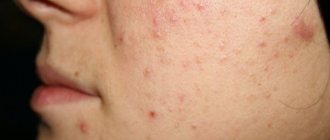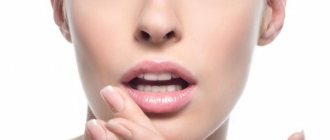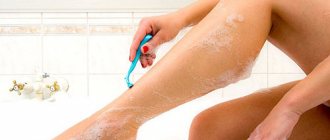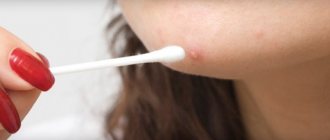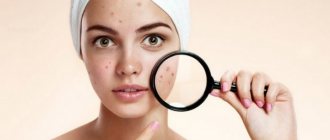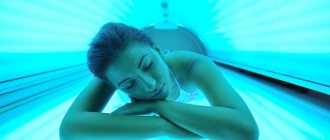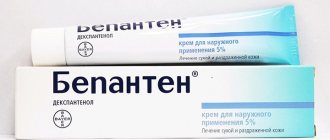Acne can appear not only in adolescence, but also in adulthood. These nodules sometimes become inflamed and fester. Due to lack of knowledge, they are often squeezed out with their own hands, risking scars.
A pimple is a skin disease that is formed as a result of dysfunction of the sebaceous glands. They are often called blackheads or acne. Areas of localization are the face, back and chest.
Mechanism of acne formation
In adolescence, the appearance of acne is promoted by changes in hormonal balance (the influence of testosterone). It affects the functioning of the sebaceous glands, causing them to produce excess sebum (sebum).
According to physiological characteristics, sebum provides hydration and protection of the skin from external irritants. Its accumulation in excess quantities and combination with keratinized particles of the skin form a shell on its surface. Sebum continues to be produced and accumulated and forms a plug. When exposed to oxygen, it undergoes an oxidation process and turns into a blackhead (blackhead).
Attention! The sebaceous plug is a favorable environment for the growth and reproduction of bacteria, as a result of which blackheads turn into pimples.
Causes of acne
The appearance of acne may be due to genetic predisposition and oily skin type. All other reasons are divided into internal and external. Endogenous factors include:
- hormonal imbalance;
- diseases of the reproductive system;
- disorders of the gastrointestinal tract;
- strong psycho-emotional shocks;
- seborrhea.
Exogenous provoking factors:
Classification
In medical practice, it is customary to divide acne into inflamed (papules, pustules and cysts) and non-inflamed (comedones). According to the first class there are:
- Newborn acne. Their formation is facilitated by maternal hormones that enter the child’s body during intrauterine development or childbirth. They appear as white dots on the face. These elements do not require treatment and disappear after normalization of hormonal levels.
- Juvenile. Diagnosed in children of the first years of life. They require mandatory consultation with a doctor and examination, as they may indicate a violation of the functional ability of the adrenal glands.
- Youthful. They are formed during puberty, between the ages of 12 and 16 years. They may appear in the form of comedones, papules, pustules and cysts.
- Adults. Occurs in women before the start of the menstrual cycle and during menopause and in men over 40 years of age. Provoking factors are changes in hormonal balance, endocrine diseases, polycystic ovary syndrome, adrenal tumors.
The rash can manifest itself as an inverse rash, inflammation of the sweat glands of the perineum and armpits in the form of the formation of purulent nodes.
The reasons for their appearance are a response to taking steroid drugs and anabolic steroids; they are called bodybuilding acne. The localization areas for such formations are the neck, décolleté and shoulders. They appear as nodules that disappear after normalization of hormonal levels (refusal to take hormonal medications).
- Contact. Such acne is manifested by an allergic reaction in response to an irritant (cosmetics, personal skin care products, sun rays).
- Elements of the rash are of mechanical origin, caused, for example, by rubbing the skin on clothing or scratching with hands.
Non-inflamed acne is divided into:
- Closed acne – they form on the lower parts of the pores. The ducts of the sebaceous glands become dilated, and an internal wen appears. On palpation, a small compaction is felt.
- Open - these pimples form at the exit of the pores and have the appearance of black dots.
Their formation is facilitated by bacteria that have penetrated into the blocked duct. Such formations are divided into:
- papules - rise above the surface of the skin, look like hyperemic balls without a cavity and a white head. Their sizes can reach 3 cm;
- pustules - look like an abscess filled with purulent exudate up to 1 cm in diameter. They can form against the background of a papule or independently.
Acne stages and their characteristics
The United States Academy of Dermatology has proposed classifying acne according to severity.
- 1st degree. It is manifested by the appearance of pimples without signs of an inflammatory process. They can be diagnosed at any age.
- 2nd degree. It is characterized by the formation of black and red spots, as well as inflamed acne. The number of elements of the rash does not exceed 11; they are most often diagnosed in adolescence and in women during their menstrual periods. Treatment is carried out at home. If there is no effect within 3 weeks, you will need to consult a dermatologist.
- 3rd degree - manifested by numerous purulent and inflamed pimples on the skin of the body and face. In this situation, treatment will be required under the supervision of a doctor.
- Grade 4 – severe. The formation of a large number of rash elements of various sizes and types is observed. Acne rots and bleeds, and pigment spots are present. This condition cannot be allowed to continue, as it poses a serious threat to health. In this case, long-term combination therapy is necessary.
Difference between pimples and blackheads
Pimples are small, inflamed and hyperemic bumps on the skin that are formed as a result of infection in clogged sebaceous glands.
Acne is an inflammation of the sebaceous glands, but at the initial stage of development. They appear as black dots that can be easily seen with the naked eye. They are divided into two types:
- black (comedones). They are usually localized on the surface of the skin. Comedones can appear due to blockage of the hair follicle and blocking of the ducts with skin scales and sebaceous secretions;
- white (wen). They form in the deeper layers of the skin and look like small nodules.
Attention! Pimples appear as a result of untreated blackheads (blackheads).
Prevention
To reduce the risk of acne recurrence or formation, it is recommended:
- Wash your face less often, as this stimulates increased sebum production.
- Avoid using skin care products made with alcohol.
- Follow the rules of rational nutrition.
- Avoid exposure to stressful situations.
- Spend more time outdoors.
- Use sunscreen.
At the initial stage. They are expressed as black dots and small nodules on the surface of the skin. There are two types of acne. Comedones are points that arise as a result of blockage of the mouth of the hair follicle or duct. They consist of thick sebum, dead skin cells and epithelial scales. At first the dots are transparent, and then, under the influence of oxygen, they oxidize and they become black. Comedones are always found on the surface of the skin. Wen (blackheads) - are formed as a result of fat congestion in the lower part of the pore. Their structure is similar to a blood clot that does not reach the surface of the skin. They may not be visually noticeable, but only noticeable when applied to the skin. They become inflamed in the deep layer of the skin and look like small nodules.
Acne has many faces, its progression depends on the type of skin and is individual for each person. Whiteheads often form on the chin, cheeks, cheekbones and forehead. They do not cause pain and do not become inflamed. Despite their harmlessness, wen are capable of combining with neighboring pimples, resulting in the formation of a large cavity filled with. Therefore, it is worth paying attention to them and taking measures to eliminate them.
Large pimples appeared on the face: what to do?
Usually, if large white pimples appear on the face, they will go away on their own over time. But it happens that they can have serious consequences in the form of scars. There are several types of large pimples. Some, others, and some choose a face as their location. Treatment for each type of acne is chosen individually, because it may happen immediately, or it may take a long time to mature.
As a result of improper skin care, large acne appears on the face. And you shouldn’t disguise them under a thick layer of cosmetics. It would be better to contact a dermatologist who will prescribe comprehensive treatment and give directions for the necessary tests. The most common remedies in the fight against large acne on the face are Zinerit or Roaccutane. They are effective in treating all types of acne and are also easy to purchase at the pharmacy.
Large subcutaneous pimples on the face
Large ones look like hard swellings under the skin that have an inflamed appearance. The difference from regular acne is that they are located deep under the skin and are not able to come out. Large subcutaneous pimples take a very long time to mature, from several days to several weeks. If you squeeze out such a pimple, the inflammation may intensify and traces of such pimples may take several months to disappear.
Large subcutaneous pimples cause harm not only to appearance. Located deep under the skin, at the location of the hair follicle, they are a breeding ground for bacteria. And this is fraught with serious consequences.
Large red pimples on the face
Big for all sorts of reasons. And just like other types of acne, large red pimples don't make your face look attractive. But they only create a repulsive impression. There are actually several reasons, here are some of them:
Malfunction of the gastrointestinal tract;
Drinking alcohol and smoking;
Stressful situations;
Improper facial care (excessive use of decorative cosmetics);
Hormonal imbalance in the body;
Unbalanced diet, eating fried, salty, smoked foods;
Improper functioning of the sebaceous glands.
By identifying the cause of the appearance of large red pimples on the face and starting treatment on time, you can achieve quick results in cleansing your face in a short time. Therefore, from the very beginning, direct all manipulations to eliminate the cause that caused the inflammation and acne will go away on its own without much effort or medical services.
Red pimples on the face: what treatment is there to get rid of?
The main thing is to choose the right method. Usually, when acne appears, a person resorts to a cosmetic method to eliminate it. And that's wrong. After all, making up red pimples under a layer of foundation and powder will not solve the problem. And clogged pores will become even more inflamed and over time, acne will leave indelible marks and scars on the face.
Therefore, first you need to contact a dermatologist, who, after prescribing a series of tests, will decide how to carry out treatment. The medicinal method consists of using ointments against acne, the most popular are Skinoren and Baziron AS. If this does not bring the desired results, a course of antibiotics will be prescribed. As a result, acne will disappear without a trace and will no longer bother you.
If you don’t have time to contact a specialist, you can use home methods to combat red pimples - this is aloe juice, lemon lotions, as well as lotions with an aqueous solution of sugar and soda.
The main thing is to start treatment on time to avoid deep inflammation on the face and skin infections. But you shouldn’t get carried away with home methods; it’s better to find time to go to the doctor. Because the face is the mirror of a person. And a red, inflamed face will at least create a repulsive effect.
Large pimples on the face: what causes them?
They are identical in nature. But a subcutaneous pimple differs from a regular pimple in that pus accumulates inside the skin and is not able to come out. This is fraught with deep difficulties, and the main thing here is to clarify in time the reason that contributes to the occurrence of acne.
The most important reason is violation of personal hygiene rules. Touching your face with contaminated hands can cause inflammation on the skin. Also, excessive facial skin care and frequent use of decorative cosmetics cause rashes on the face.
The second reason for the appearance of large pimples is the common cold. After all, it is reduced immunity. Prevents the body from dealing with sudden acne.
Other important reasons are a malfunction of internal organs, mainly the gastrointestinal tract, unhealthy diet and unhealthy lifestyle, hormonal changes both in adolescence and in older people. Frequent stress and disorders of the central nervous system provoke inflammatory processes.
Large pimples on the face: prevention of occurrence
To prevent acne, you should adhere to the following rules:
Visit a cosmetologist who will help you choose the right cosmetics according to your skin type;
Try to be less nervous and avoid conflict situations, and not become depressed;
Undergo an annual medical examination, which can promptly identify emerging health problems and begin treatment for the disease;
Adopt a healthy lifestyle, play sports and spend more time in the fresh air.
By following these simple rules, your facial skin will be clean and healthy. And acne will be a thing of the past.
The carbuncle is the largest pimple in the world. Translated from Latin, carbunculus literally means “coal”.
The difference between pimples and blackheads
Pimples and blackheads can appear not only during puberty, but also as a result of endocrine and hormonal changes in the body. Digestive problems, poor diet, and excessive amounts of cosmetics can also be a favorable factor for their appearance.
A pimple is an inflammation on the surface of the skin, small bumps with redness, usually caused by infection in clogged sebaceous glands.
The main difference between an inflamed pimple and an acne is its appearance. A pimple catches your eye, disfiguring your appearance.
The presence of infection is also a difference. Causing inflammation, the infection provokes redness, suppuration and causes tissue swelling, while causing discomfort and pain.
At their core, acne is the ancestor of acne. Sometimes, in order to eliminate skin diseases such as acne and pimples, it is enough to eliminate the cause of their occurrence: stop using low-quality cosmetics, balance your diet and systematically cleanse the skin of the sebum it produces.
Not every person can boast of ideal healthy skin. Most people experience acne during puberty. And for some people, these rashes accompany them throughout their lives.
Many men and women do not know how this type of inflammation differs from acne and blackheads. In fact, it is quite easy to distinguish them by their typical external features.
So, what are the differences? In order to understand this issue, you need to know how the skin works.
What are acne
In medical terms, there is no such word as “acne.” Any skin formation has its own name:
- comedo;
- papules;
- pustules;
- furuncle;
- abscess;
- wen;
- acne.
Many people call any bump on the skin a pimple, since it is impossible to determine by looking what the nature of a particular formation is. It is important to understand that not all stages of acne can be called acne. They have their own distinctive appearance, and different processes occur in each of them, so they are treated differently. Acne is a pathology of the skin, which is accompanied by inflammation of the sebaceous glands. They can be divided into several categories:
- Carbuncles
. A formation that has a convex shape, redness with a blue tint, located in various places on the skin. - Furuncle
. Inflammation of the hair follicle with pus in the layers of the epidermis. - Prosyanka
. A nodular formation located deep under the skin in the layers of the epidermis.
Acne can also occur due to poor heredity and if a person has oily skin. In addition, there are other factors that increase the likelihood of acne:
- stressful situations;
- hormonal imbalances;
- allergic reactions;
- critical days;
- taking certain medications;
- taking oral contraceptives;
- industrial pollution.
Clean skin is the key to excellent health and beauty, but the presence of any formations on the skin spoils the appearance and also causes discomfort.
Each person must distinguish between blackheads and pimples in order to be able to effectively get rid of them. Not every person can boast of ideal healthy skin. Most people experience acne during puberty. And for some people, these rashes accompany them throughout their lives.
Many men and women do not know how this type of inflammation differs from acne and blackheads. In fact, it is quite easy to distinguish them by their typical external features.
So, what is the difference between pimples and blackheads? In order to understand this issue, you need to know how the skin works.
The structure of human skin
It is the largest organ in the body and performs many functions. The first is a protective cover. The upper layers of the dermis protect all other cells from external factors. The second most important function is thermoregulation. With the help of many small pores that evaporate water, the human body does not overheat in extreme heat. And, of course, the skin allows us to sense the world around us tactilely. A person receives most of the information through the organs of hearing and vision. But a significant part is transmitted through the skin.
The thickness of the skin varies. It can be 0.1-4 mm in different parts of the body. The skin consists of three layers:
Acne
Each hair on the human body is located inside a separate channel. This opening is connected to the sweat and sebaceous glands. The latter is needed for the production of sebum. It is released to the surface and covers the hair shaft and skin with a thin protective lipid film. However, sometimes a sebaceous plug forms at the exit of the canal. Subcutaneous fat begins to accumulate inside, which, if things go wrong, leads to inflammation. This is the cause of acne and pimples. And the differences between them are not as global as they seem at first glance.
Acne
Skin rashes can take many different forms. And depending on its appearance and characteristic signs, they are classified as different types of inflammation. So what are the differences between acne, pimples and acne? In order to understand this, you need to know what the different forms of rash look like.
Let's start with eels. These formations on the skin are fat plugs. Sometimes they look like whitish spots - these are rosacea that are located under the skin. They are also called milia.
Blackheads (blackheads) are comedones. They acquire this color due to the fact that they are formed in enlarged, open pores, and sebum darkens with access to oxygen.
None of them should be squeezed out. Otherwise, there is a risk of infection and only worsening the problem. Although regular cosmetic cleansing procedures - salon or home - will help deal with open blackheads.
Blackheads and acne
If acne is just a small thing, then acne is a real epidemic. People aged 21 to 30 suffer the most from this disease. In terms of symptoms, acne resembles acne, but it consists of entire islands of acne, after recovery of which deep scars are formed in the areas of inflammation - indentations in the relief of the dermis.
Initially, the cause of acne was considered to be hormonal imbalance and bad eating habits. But acne is a multifactorial skin disease that occurs under the influence of viruses in a pathogenic environment. Acne can appear against the background of gastritis, flu, food poisoning due to the active proliferation of harmful bacteria and weak immunity. Subcutaneous mites, fungi of the intestinal flora, staphylococci increase their number, distorting the pH of sebum, converting the acidic environment into an alkaline one. The mouth of the sebaceous gland is expanded and allows any infection into the dermis.
READ ALSO: Foundation for problem skin: rating of the 5 best products
Pimples or acne: types
What is the difference between pimples and blackheads? When subcutaneous sebum accumulates for a long time, comedones and milia increase in size. A nutrient medium for the proliferation of bacteria is formed in the rod canal. Once infection occurs, the follicle becomes inflamed and pus appears. These are pimples, or acne. In the process of development, they can take on various forms:
- Papule. Inflammatory process without visible pus. The pimple looks like a red or bluish swelling. Over time it fades and goes away.
- Pustule. A pimple with a white head of pus in the center. It can develop independently or degenerate from a papule.
- A serious dermatological disease in which pustules do not form individually, but fill large areas of the skin. Without a visit to the doctor and treatment with special medications, it is impossible to get rid of such a rash.
- Lightning acne. They are manifested not only by a rash on the skin, but also by painful sensations in bone and muscle tissue. The inflammatory process goes so far that it can be seen in blood tests. Requires immediate medical treatment.
- A node is a large inflamed area.
In particularly severe cases, acne becomes abscesses or boils.
Now you know, all that remains is to understand what the difference is between them. After all, if you do not have this information, you can only aggravate the problem by attempting incorrect treatment.
Pimples and blackheads
Acne on the skin is a pathological focus in the sebaceous glands of the skin, which is prone to inflammation.
Such a formation may look simply like a black dot, sometimes almost invisible to the eye. However, in response to any change in the body, acne can become inflamed, red and fester. This process is accompanied by painful sensations, resulting in the formation of a pustular capsule on the skin - a pustule. Active inflammation can be triggered by damage (for example, self-squeezing) and infection, decreased immunity, all sorts of health problems and hormonal disorders.
Inflamed, red, and painful areas on the skin are most often referred to as pimples. But what is the difference between pimples and blackheads?
Acne may look like:
- Comedonov. These are classic blackheads that can be seen with the naked eye.
- Wen - small bumps under the skin.
- Papules or pustules (with the addition of an inflammatory process).
Dermatologists do not use the term "acne" in their practice. Each skin formation has its own medical name. In particular, pimples can be comedones, papules, pustules, boils, ulcers, wen, and acne.
Difference between blackheads and pimples
How to get rid of skin rashes? Treatment methods will depend on the form and stage of the disease. In fact, this is not a complete classification of skin rashes. They can differ in the degree of inflammation, the causative agents of the infection, the shape of the pimples and various specific reasons that cause their appearance. For example, a separate group of rashes includes inflammation in bodybuilders caused by taking certain drugs (steroid acne). There are inverse ones, the area of appearance of which is limited to the armpits, groin and abdomen. Or juvenile acne, which most dermatologists consider an absolutely normal phenomenon that goes away on its own after puberty.
So what is the difference between blackheads and pimples and how to treat them? In fact, they are practically the same thing. Pimples and blackheads are different stages of clogged pores on the skin. In some people, this disease takes on relatively harmless forms, while in others it is complicated by concomitant infections.
Acne: causes, treatment
Acne (acne, blackheads) is a skin disease that affects people all over the globe. Every year, more than 50 million residents of the CIS are susceptible to this disease to one degree or another; According to statistics, acne is one of the most common skin diseases in the countries of the former Soviet Union.
The question “How to get rid of acne?” sounds on every women's forum. It would seem that so many notes and articles have already been written about this, so many cans of Klerasil have been poured out, but there are no fewer women and girls with problem skin.
First of all, it must be said that some girls shout “save me, help me” because of a couple of small pimples that periodically pop up, while for others, pimples are no longer pimples at all, but acne is a serious problem that spoils the appearance and poisons life .
Let's first figure out in what cases we can cope on our own, and when we need to sound the alarm.
So, the first trouble that owners of oily skin face is blackheads, also known as comedones.
Among the most likely causes of acne are:
- heredity;
- hormonal imbalance;
- poor nutrition;
- avitaminosis;
- lack of hygiene;
- diseases of the gastrointestinal tract, endocrine system;
- alcohol or smoking abuse;
- stress;
- comedogenic cosmetics;
- climatic conditions.
To treat pimples and blackheads on the face, you must first determine the cause of their appearance. This may be a consequence of poor diet, environmental factors, improper skin care, medication use, etc. Plus, oily facial skin contributes to the appearance of inflammation. There is no concept of “pimple” in medicine.
Inflammation of the epidermis, often referred to as “acne,” is a disease of the sebaceous glands and hair follicles. However, for its treatment or prevention, it is necessary to clearly distinguish between concepts such as “acne” and “pimples”, because there is a big difference between them. Their manifestations and causes differ from each other, and accordingly, the treatment will be different.
Treatment
How do pimples differ from acne in terms of treatment? The difference is not so global. The fact is that on your own, without consulting a doctor, you can only try to get rid of comedones, milia, papules and single pustules. Everything else requires more serious drug therapy.
Acne and pimples can be treated using approximately the same medications. But in the first case, it is better to focus on products that cleanse and tighten pores, removing fat from the skin. And in the second case, the drugs must additionally have antimicrobial and anti-inflammatory effects.
Cleansing cosmetics: pros and cons
Not all products that are supposed to cleanse the face of fat and blackheads are equally useful. Some of them dry out the skin greatly, which only aggravates the problem. In addition, scientists have found that oily skin, no matter how strange it may sound, may lack certain fatty acids. And an excess of secret is precisely an attempt to restore balance. Therefore, cleansing cosmetic products alone cannot always get rid of acne and pimples. The problem needs to be solved from the inside with the help of a dermatologist.
How are blackheads different from pimples? The same medications are used to get rid of these rashes. In serious cases, other treatment is necessary, but in such a situation only a doctor prescribes medications.
Today, products from several popular brands are used to get rid of skin rashes. Let's look at them in more detail.
"Proactive"
What is the difference between pimples and blackheads? The main difference is that comedones can be removed from the face using a scrub. And if the inflammatory process is already underway, then this is absolutely forbidden. Such actions can only spread the infection to other areas of the skin.
Therefore, the products are designed specifically to combat acne. This is a line of products consisting of cream, tonic and scrub. Active ingredients - benzoyl peroxide and sulfur - remove blackheads and prevent their further occurrence.
A positive effect is observed in 60-65% of cases and lasts for a long time - from several weeks to two months.
How to choose medications?
They must meet a number of requirements:
- do not contain substances that irritate the skin;
- do not clog pores, thereby aggravating the problem;
- do not destroy the epidermis;
- do not kill beneficial bacteria on the surface of the skin;
- do not interfere with the normal functioning of immune cells.
At the same time, the drug must cope with its main function, that is, rid the skin of acne and pimples. This means that it must contain substances that reduce sebum production, tighten pores and destroy bacteria. It is difficult to combine all of the above in one medicine.
Therefore, quite often you can find components that bring both benefit and some harm, namely:
- Benzoyl peroxide. It is effective in the fight against blackheads, but it dries out the epidermis greatly.
- Azelaic acid. Natural component with antimicrobial effect. Often causes skin irritation.
- Glycolic acid. Exfoliates dead scales of the epidermis, prevents clogging of the sebaceous glands, but at the same time provokes the release of inflammatory neuroleptics.
- Salicylic acid. It gives quick results, helps cope with inflammation, but greatly dries out the epidermis.
Now you know how blackheads differ from pimples. If you do not neglect this problem, use special preparations and recommendations from a dermatologist, you can get the desired result, namely healthy and clean skin.
A clean face has always been considered the basis of beauty and a sign of good health. However, sometimes our appearance, unfortunately, is spoiled by uninvited guests in the form of pimples, blackheads and other rashes. This can be a real disaster for young boys and girls, especially if they decide to go on a date or, for example, to an interview.
Comparison
Acne is divided into two types: black (comedones) and white (whet). Blackheads appear clear at first, then they oxidize when exposed to oxygen, darkening and turning black. They are usually always on the surface of the skin. Wen, unlike blackheads, become inflamed deep in the layers of the skin and look like small nodules. Comedones become inflamed as a result of the hair follicle becoming clogged, and keratinized skin flakes and sebaceous secretions clog the ducts.
Pimples and acne occur not only in adolescence, but can also appear due to hormonal and endocrine changes. They often appear on the skin due to digestive problems and poor nutrition, as well as due to unfavorable weather conditions and excessive makeup, which clogs the pores of the skin, preventing it from breathing. Sometimes, in order to eliminate the rash, it is enough to remove the factors that irritate the skin: stop using cosmetics, normalize your diet, and constantly cleanse your facial skin of secreted sebum.
Juvenile acne
According to statistics, 1/3 of teenagers face this problem. Girls - more often than boys. In the vast majority of cases (up to 75%), the face is affected, in the remaining cases (15%) - the face and back. Typically, juvenile acne goes away by age 18–20. However, in some cases the disease is long-term, sometimes up to 40–60 years. This physiological acne is considered adult acne.
Among juvenile acne there are:
The most common comedones and acne are in the form of papules or pustules. Other forms are less common and require more complex treatment.
Conclusions website
- A pimple is an inflamed formation on the surface of the skin, an acne is a “black dot” on the surface.
- First, acne appears on the skin. If left untreated, acne will soon appear.
Many people think that acne is just ordinary pimples that do not require any treatment. In fact, those with true acne have the following symptoms on their skin:
- black dots;
- whiteheads, or pimples, filled with pus;
- papules;
- pustules (this is exactly what everyone calls pimples);
- cysts;
- nodules.
Acne appears on the face, back, chest, neck, shoulders and buttocks.
In addition to acne, patients may experience other phenomena that usually accompany acne:
- Low self-esteem. Many of those who have acne on their face say that they are embarrassed by others, so they avoid communicating with people and even close friends. For the same reason, they begin to miss classes in educational institutions and work, and this, as we know, does not lead to anything good.
- Depression. In addition to low self-esteem, those with acne may also experience depression. This phenomenon is dangerous because patients may sooner or later have thoughts of suicide. Studies conducted in Western countries have shown that many teenagers with acne on their faces have considered committing suicide at least once in their lives.
- Dark spots on the skin. They appear after the pimple begins to heal. It will take many months and even years for the stains to completely disappear.
- Scarring. Acne scars usually last a lifetime. Their formation can be prevented if you consult a dermatologist in time and begin treatment. This is especially true for the early manifestation of acne between the ages of 8 and 12 years. If someone in your family has acne, and you have it, you should immediately consult a doctor without wasting time to prevent its possible consequences.
Reading these lines, you are probably interested in finding a way to get rid of acne, finding a way to effectively improve the condition of your skin. And we will tell you how to do it. Today, there are methods developed by laser medicine that can simultaneously treat, disinfect and smooth the surface of the skin. This means that the problem of acne can be solved comprehensively.
To select treatment, consultation with a specialist is necessary. Please familiarize yourself with the following materials in advance: ACNE TREATMENT WITH PHOTON LASER and LASER FACIAL GRINDING, effective at any age, for beauty and health of the skin. We are waiting for you at the Liana clinic at a time convenient for you!
What is acne
Acne can be considered a childhood horror story compared to the horror called acne. The first is a slight ailment, the second is a real skin disease.
According to statistics from Massachusetts General Hospital, acne affects 45% of people aged 21 to 30, 26% of people aged 31 to 40, and 12% of people aged 41 to 50. The results of research from the American Academy of Dermatology are also amazing: 50 million people have acne in the United States alone. Doesn't it seem like this is a worldwide epidemic?
Acne, pimples and acne: what are the differences?
Acne is visually somewhat reminiscent of acne, but has some differences. With acne, entire islands of pimples appear on the body and face, and at the site of the inflammation that has subsided, a post-acne scar (a dip in the skin texture) forms.
Representatives of the old school often blame unstable hormonal levels and problems with the digestive tract for acne. However, the disease can manifest itself even if everything is fine with these systems.
“Acne is a multifactorial inflammatory skin disease. It develops against the background of the introduction of viruses into the body and the development of pathogenic flora,” says Lyubov Khachaturyan, MD. MAN, full member of OSEM, member of the International Society of Mesotherapy, dermatovenereologist, cosmetologist, head of the Rosh medical center.
Our body is made up of bacteria, they mainly work for our survival. When an infection occurs (for example, poisoning, flu and even gastritis) against the background of existing diseases and reduced immunity, an army of certain bacteria can increase their numbers and begin a harmful attack on the skin.
Basically, bacteria such as subcutaneous mites (Demodex), candida albinax (fungi of the intestinal flora), staphylococci and Propionibacterium acne go “to the dark side”. These species are always present in the flora of the body, the latter even help protect the epidermis from attacks from the external environment. By multiplying and increasing their numbers, they begin to work exactly the opposite. Bacteria change the pH of sebum, turning the acidic environment that kills germs into alkaline.
Thanks to their activity, the bactericidal properties of sebum are suppressed, the very mouth of the sebaceous gland expands, and this opens the gates for the penetration of any infection. It is its development that leads to the appearance of inflammatory elements on the surface of the epidermis.
Acne treatment
Lyubov Khachaturyan assures that acne cannot be gotten rid of with the help of the most expensive anti-acne series and miraculous vitamins. Treatment should take place under the strict supervision of a specialist. The recovery process will take quite a long period, so coordinated work in a team of dermatocosmetologist and patient is necessary, consisting of 4 stages:
1. History taking
At the first stage, the specialist must determine the cause or causes of acne, which pathogenic flora contributed to the development of the disease. Therefore, you will have to undergo a series of tests, including to study the components of the sebaceous plug itself. Only after finding out the reasons will the doctor prescribe a course of treatment.
When the first positive results appear, it is very important not to give up treatment and fight the disease to the bitter end. The period of all tests takes at most six months.
3. Diet
Depending on what pathogenic flora prevails in the body, the doctor may prescribe a specific diet for you. For example, if Candida fungi have taken over, then fermentation products - dairy, sweets - are removed from the diet; if demodicosis prevails - smoked foods, fried foods, fatty foods.
4. Post-rehabilitation period
Even when the disease is defeated, at first it will be necessary to periodically visit the doctor and consult about care.
Not every person can boast of ideal healthy skin. Most people experience acne during puberty. And for some people, these rashes accompany them throughout their lives.
Many men and women do not know how this type of inflammation differs from acne and blackheads. In fact, it is quite easy to distinguish them by their typical external features.
So, what are the differences? In order to understand this issue, you need to know how the skin works.
